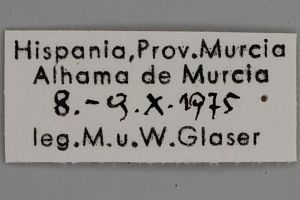Version 12 / 14 vom 7. August 2023 um 19:29:02 von Erwin Rennwald
Länder:

 +2Kontinente:EUAF
+2Kontinente:EUAF


 +2Kontinente:EUAF
+2Kontinente:EUAFInhalt
2. Diagnose
2.1. Geschlecht nicht bestimmt
2.2. Erstbeschreibung
1: Walsingham (1907: 194) [nach Copyright-freiem Scan auf www.biodiversitylibrary.org]
3. Biologie
3.1. Nahrung der Raupe
Noch unklar! Hollingworth et al. (2002: 428) schrieben: "Enfin, toujours au sujet de cette espèce, King (2001) signale pour la première fois les plantes-hôtes de la chenille; elle serait polyphage sur des Astéracées, des Fabacées et des Plantaginacées." Die Originalarbeit von King (2001) konnte ich leider noch nicht studieren. Bis dahin habe ich meine Zweifel daran, dass diese Angaben durch konkrete Freiland-Beobachtungen abgesichert sind - möglich ist dies aber schon.
(Autor: Erwin Rennwald)
4. Weitere Informationen
4.1. Andere Kombinationen
- Tortricodes polita Walsingham, 1907 [Originalkombination]
4.2. Literatur
- Hollingworth, T., Nel, J. & R. Mazel (2002): A propos de deux Microlépidoptères méconnus en France, Oxypteron politum (Walsingham, 1907) et Elachista nolckeni Sulcs, 1992, correctif et compléments (Lepidoptera, Tortricidae et Elachistidae). — Bulletin de la Société entomologique de France 107 (4): 427-428. [PDF auf persee.fr]
- King, G.E., (2001): Contribution to the knowledge of the biology of Oxypteron schawerdai (Rebel, 1936) (Lepidoptera: Tortricidae). — SHILAP Revista de Lepidopterología, 29 (114): 125-129. [Sekundärzitat]
- Erstbeschreibung: Walsingham (1907): Algerian Microlepidoptera. — The Entomologist's Monthly Magazine 43 (= second series 18): 6-10, 55-58, 125-129, 147-154, 187-195. London (Gurney & Jackson).







